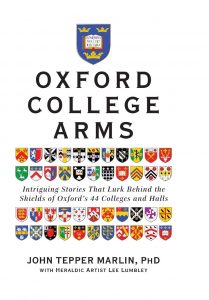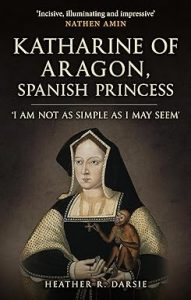I am delighted to host this guest article by John Tepper Marlin.
John’s book, ‘Oxford College Arms: Intriguing Stories Behind Oxford’s Shields’ was published by Boissevain Books LLC in September last year.
You can buy it from:
Thank you to John for this article.
If Lady Jane Grey had extended her reign, how might the colleges at Oxford developed?
Six colleges were founded under the Tudors, whose dynasty started with Henry VII, son of Lancastrian Edmund Tudor and Margaret Beaufort, a descendant of Edward III. Henry VII was brought up in Wales but had exiled himself to France while the Yorkists were in power. When Yorkist Richard III acceded to the throne in 1583, he soon made himself unpopular. Henry VII returned to Wales and assembled an army that defeated and killed Richard III at Bosworth Field in 1485 and was crowned king in London. By marrying Elizabeth of York the following year, Henry VII united the Houses of Lancaster and York.
Brasenose College (1509). No Oxford colleges were formally founded during Henry VII’s reign. But two Oxford colleges were founded early in his son Henry VIII’s reign, by the Bishops of Lincoln and Winchester, i.e., Brasenose and Corpus Christi Colleges.
Brasenose was the first college to have a non-religious founder, a Cheshire lawyer, along with a bishop from Lancashire. It became a magnet for students from Cheshire and Lancashire, and was the home college of Rev. Lawrence Washington, great-grandfather of George Washington, whose ancestors came from near Newcastle, in the metropolitan area (since 1972) of Tyne and Wear.
Corpus Christi College (1517). Corpus Christi was founded by Richard Foxe, Bishop of Winchester, and became a center of humanistic study through the influence of Bishop Hugh Oldham of Exeter. The use of a pelican in the dexter third of the Corpus arms is based on the medieval idea that the pelican pierced its breast to feed blood to its young. The analogy to the sacrifice of Jesus is compelling. We now know that the pelican is actually thumping its beak on its breast to disgorge food from the pouch under its beak.
Both Brasenose and Lincoln use tierced coats of arms, their episcopal See in the center pale of the arms. Using the third pale is visually challenging, and including the arms of a See along with the personal arms of the founding bishop, is heraldically improper.
Christ Church (1546). Cardinal Thomas Wolsey, the leading churchman in the early years of the reign of Henry VIII, also planned for a college at Oxford to be named Cardinal College. He gave it his (created) episcopal coat of arms, which is a collection of symbols of his commoner origins. When Wolsey and Henry VIII parted ways over the king’s divorce of Catherine of Aragon, Henry in 1546 completed the foundation of the college, which he called Christ Church. It stills bears Wolsey’s arms.
Henry VIII was succeeded by his sickly son Edward VI, who only lived six years into his reign, which was controlled by his Protestant courtiers. In his will, Edward directed that Lady Jane Grey be named his successor. Lady Jane is known as the Nine-Day Queen, but her reign might be considered a few days longer. Lady Jane’s reign ended when an effort to capture a possible challenger, Catholic Mary Tudor, ended with Mary’s being championed and named the rightful heir to the throne. The plotters against Mary I were executed and so eventually was Lady Jane (and her husband); she was venerated for several hundred years as a Protestant martyr.
Trinity College (1555). During the reign of Mary I, two colleges were founded, on land previously occupied by Durham College, which was established by the Prince Bishop of Durham for the novices at his Benedictine monastery. The main buildings of the dissolved Durham College were used as the site for Trinity College, founded by Sir Thomas Pope, who had made his fortune during the reign of Henry VIII taking over and disposing of the monastic lands.
Consumed by guilt at his self-enrichment at the expense of the monks, and not having offspring to pray for his soul, Sir Thomas founded the college to ensure that his soul was prayed for daily, a wish that is still complied with by the college. The arms of the College are those of Sir Thomas.
St. John’s College (1555). The same year that Sir Thomas Pope founder Trinity College, his friend Sir Thomas White, also childless, founded St. John’s College. White was an ally of Mary I in the proceedings against Lady Jane, and was rewarded with a knighthood. White was a clothier and named the college after St. John the Baptist, who is said to have made his own garments.
White’s executor was an astute investor, and St. John’s prospered as the value of Oxford real estate grew. In 2018, it was at the top of the “Norrington Table”, which measures the academic performance of the colleges based on the undergraduate examination results.
Jesus College (1571). After the death of Mary I, her younger sister Elizabeth I took the throne for 44 years. Jesus College was the only Oxford college founded during her reign; its creation was instigated by the Treasurer of the Welsh St. David’s Cathedral, where Edmund Tudor is buried.
Jesus College bears the arms of Yorkshireman Thomas Rotherham, Bishop of Lincoln, and no one is sure why. Most likely when Jesus College was renting space from Rotherham, his arms were recorded and were assumed to be the arms of the college. Jesus College’s Welsh connections are widely known, and Welshman T. E. Lawrence (“Lawrence of Arabia”) studied there.
Summing Up. To answer the question posed at the opening, if Lady Jane Grey had extended her reign, Catholic Mary I would probably not have taken the throne and the two colleges founded during her reign, Trinity and St. John’s, would not have been founded by two Catholic knights looking for students to pray for their souls.







































